Disentangling the Spatiotemporal Dynamics, Drivers, and Recovery of NPP in Co-Seismic Landslides: A Case Study of the 2017 Jiuzhaigou Earthquake, China
Abstract
1. Introduction
2. Materials and Methods
2.1. Study Area
2.2. Data
2.2.1. NPP Datasets
2.2.2. Meteorological Data
2.2.3. Topographic and Geological Data
2.3. Methods
2.3.1. Vegetation Productivity Capability
2.3.2. Geographical Detector
- (1).
- Factor detector
- (2).
- Parameter optimization
- (3).
- Interaction detector
2.3.3. Ecosystem Resilience
3. Results
3.1. NPP Spatiotemporal Dynamics in Co-Seismic Landslides
3.2. NPP Recovery Rate in Co-Seismic Landslides
3.3. Driving Factors of NPP Recovery in Co-Seismic Landslides
3.3.1. Optimal Discretization of Continuous Variables
3.3.2. Effect of Single Variables on NPP Recovery
3.3.3. Effects of Variable Interactions on NPP Recovery
4. Discussion
5. Conclusions
- Before the earthquake, the NPP in the co-seismic landslide area remained stable, fluctuating between 525 and 575 g C/m2. However, following the earthquake, it dropped to 533 g C/m2. This decline was exacerbated by extreme rainfall events in 2018, 2019, and 2020, causing the NPP to further decrease to 483 g C/m2. Recovery commenced in 2021, and by 2022, the NPP had rebounded to 544 g C/m2.
- Five years after the earthquake, 18.88% of the co-seismic landslide areas exhibited an NPP exceeding pre-earthquake state. However, 17.14% of these areas had an NPP recovery rate of less than 10%, indicating that recovery has barely begun in most areas. Notably, 81.82% of the area remains completely unrecovered. Within this, 24.39% is nearing the pre-earthquake state, while a significant 57.43% remains in a suboptimal state.
- The factor detector indicated that temperature, precipitation, and elevation significantly influence the recovery of NPP in co-seismic landslide areas, while the interaction detector revealed that lithology, slope, and aspect, when interacting with other factors, also play a crucial role in the recovery. Therefore, the recovery of NPP is not determined by a single factor, but rather by the interactions among various factors.
- The current recovery of NPP is predominantly driven by the restoration of grassland ecosystems. In stark contrast, forested areas have not only failed to recover in the five years following the earthquake but have continued to decline. While the potential for recovery of NPP in co-seismic landslide areas to the pre-seismic state is optimistic, achieving the pre-earthquake state will be a protracted process, requiring considerable time.
Author Contributions
Funding
Data Availability Statement
Acknowledgments
Conflicts of Interest
References
- Liu, Y.F.; Xu, M.; Guo, B.; Yang, G.; Li, J.L.; Yu, Y. Changes in the Vegetation NPP of Mainland China under the Combined Actions of Climatic-Socioeconomic Factors. Forests 2023, 14, 2341. [Google Scholar] [CrossRef]
- Quan, Y.Y.; Hutjes, R.W.A.; Biemans, H.; Zhang, F.S.; Chen, X.P.; Chen, X.J. Patterns and drivers of carbon stock change in ecological restoration regions: A case study of upper Yangtze River Basin, China. J. Environ. Manag. 2023, 348, 119376. [Google Scholar] [CrossRef]
- Yadav, V.S.; Yadav, S.S.; Gupta, S.R.; Meena, R.S.; Lal, R.; Sheoran, N.S.; Jhariya, M.K. Carbon sequestration potential and CO2 fluxes in a tropical forest ecosystem. Ecol. Eng. 2022, 176, 106541. [Google Scholar] [CrossRef]
- Prăvălie, R.; Piticar, A.; Roșca, B.; Sfîcă, L.; Bandoc, G.; Tiscovschi, A.; Patriche, C. Spatio-temporal changes of the climatic water balance in Romania as a response to precipitation and reference evapotranspiration trends during 1961–2013. Catena 2019, 172, 295–312. [Google Scholar] [CrossRef]
- Sun, H.Z.; Chen, Y.B.; Xiong, J.N.; Ye, C.Q.; Yong, Z.W.; Wang, Y.; Xu, S.C. Relationships between climate change, phenology, edaphic factors, and net primary productivity across the Tibetan Plateau. Int. J. Appl. Earth Obs. Geoinf. 2022, 107, 102708. [Google Scholar] [CrossRef]
- Xu, J.Y.; Zhang, Y.Y.; Huang, C.B.; Zeng, L.X.; Teng, M.J.; Wang, P.C.; Xiao, W.F. Forest restoration shows uneven impacts on soil erosion, net primary productivity and livelihoods of local households. Ecol. Indic. 2022, 134, 108462. [Google Scholar] [CrossRef]
- Li, P.; Peng, C.H.; Wang, M.; Li, W.Z.; Zhao, P.X.; Wang, K.F.; Zhu, Q. Quantification of the response of global terrestrial net primary production to multifactor global change. Ecol. Indic. 2017, 76, 245–255. [Google Scholar] [CrossRef]
- Zhou, T.J.; Chen, X.L.; Wu, B. Frontier issues on climate change science for supporting Future Earth. Chin. Sci. Bull. 2019, 64, 1967–1974. [Google Scholar] [CrossRef]
- Allen, R.B.; Bellingham, P.J.; Wiser, S.K. Immediate damage by an earthquake to a temperate montane forest. Ecology 1999, 80, 708–714. [Google Scholar] [CrossRef]
- Garwood, N.C.; Janos, D.P.; Brokaw, N. Earthquake-caused landslides: A major disturbance to tropical forests. Science 1979, 205, 997–999. [Google Scholar] [CrossRef]
- Hilton, R.G.; Meunier, P.; Hovius, N.; Bellingham, P.J.; Galy, A. Landslide impact on organic carbon cycling in a temperate montane forest. Earth Surf. Process. Landf. 2011, 36, 1670–1679. [Google Scholar] [CrossRef]
- Gan, B.R.; Yang, X.G.; Zhang, W.; Zhou, J.W. Temporal and spatial evolution of vegetation coverage in the mianyuan river basin influenced by strong earthquake disturbance. Sci. Rep. 2019, 9, 16762. [Google Scholar] [CrossRef] [PubMed]
- Liu, Y.; Liu, R.G.; Ge, Q.S. Evaluating the vegetation destruction and recovery of Wenchuan earthquake using MODIS data. Nat. Hazards 2010, 54, 851–862. [Google Scholar] [CrossRef]
- Yang, Y.S.; Fan, X.M.; Wang, X.; Lv, L.Y.; Zou, C.B.; Feng, Z.T. Net primary productivity changes associated with landslides induced by the 2008 Wenchuan Earthquake. Land Degrad. Dev. 2023, 34, 1035–1050. [Google Scholar] [CrossRef]
- Wang, C.Y.; Hu, X.D.; Hu, K.H.; Liu, S.; Zhong, W. Impact Assessment of the Ms7. 0 Earthquake on Jiuzhaigou Valley from the Perspective of Vegetation Net Primary Productivity. Sensors 2022, 22, 8875. [Google Scholar] [CrossRef]
- Liu, J.; Wang, J.; Wang, S.D.; Wang, J.F.; Deng, G.P. Analysis and simulation of the spatiotemporal evolution pattern of tourism lands at the Natural World Heritage Site Jiuzhaigou, China. Habitat Int. 2018, 79, 74–88. [Google Scholar] [CrossRef]
- Hu, X.D.; Hu, K.H.; Zhang, X.P.; Wei, L.; Tang, J.B. Quantitative assessment of the impact of earthquake-induced geohazards on natural landscapes in Jiuzhaigou Valley. J. Mt. Sci. 2019, 16, 441–452. [Google Scholar] [CrossRef]
- Sun, J.B.; Yue, H.; Shen, Z.K.; Fang, L.H.; Zhan, Y.; Sun, X.Y. The 2017 Jiuzhaigou earthquake: A complicated event occurred in a young fault system. Geophys. Res. Lett. 2018, 45, 2230–2240. [Google Scholar] [CrossRef]
- Wang, J.F.; Zhang, T.L.; Fu, B.J. A measure of spatial stratified heterogeneity. Ecol. Indic. 2016, 67, 250–256. [Google Scholar] [CrossRef]
- Fan, X.M.; Scaringi, G.; Xu, Q.; Zhan, W.W.; Dai, L.X.; Li, Y.S.; Huang, R.Q. Coseismic landslides triggered by the 8th August 2017 M s 7.0 Jiuzhaigou earthquake (Sichuan, China): Factors controlling their spatial distribution and implications for the seismogenic blind fault identification. Landslides 2018, 15, 967–983. [Google Scholar] [CrossRef]
- Tian, Y.Y.; Xu, C.; Ma, S.Y.; Xu, X.W.; Wang, S.Y.; Zhang, H. Inventory and spatial distribution of landslides triggered by the 8th August 2017 MW 6.5 Jiuzhaigou earthquake, China. J. Earth Sci. 2019, 30, 206–217. [Google Scholar] [CrossRef]
- Robinson, N.P.; Allred, B.W.; Smith, W.K.; Jones, M.O.; Moreno, A.; Erickson, T.A.; Running, S.W. Terrestrial primary production for the conterminous United States derived from Landsat 30 m and MODIS 250 m. Remote Sens. Ecol. Conserv. 2018, 4, 264–280. [Google Scholar] [CrossRef]
- Turner, D.P.; Ritts, W.D.; Cohen, W.B.; Gower, S.T.; Running, S.W.; Zhao, M.; Saleska, S.R. Evaluation of MODIS NPP and GPP products across multiple biomes. Remote Sens. Environ. 2006, 102, 282–292. [Google Scholar] [CrossRef]
- Peng, S.Z.; Ding, Y.X.; Liu, W.Z.; Li, Z. 1 km monthly temperature and precipitation dataset for China from 1901 to 2017. Earth Syst. Sci. Data 2019, 11, 1931–1946. [Google Scholar] [CrossRef]
- Peng, K.F.; Jiang, W.G.; Ling, Z.Y.; Hou, P.; Deng, Y.W. Evaluating the potential impacts of land use changes on ecosystem service value under multiple scenarios in support of SDG reporting: A case study of the Wuhan urban agglomeration. J. Clean. Prod. 2021, 307, 127321. [Google Scholar] [CrossRef]
- Zhang, S.R.; Bai, X.Y.; Zhao, C.W.; Tan, Q.; Luo, G.J.; Wu, L.H.; Song, F.J. China’s carbon budget inventory from 1997 to 2017 and its challenges to achieving carbon neutral strategies. J. Clean. Prod. 2022, 347, 130966. [Google Scholar] [CrossRef]
- Zhao, J.Y.; Li, J.J.; Zuo, L.L.; Liu, G.H.; Su, X.K. Interaction dynamics of multiple ecosystem services and abrupt changes of landscape patterns linked with watershed ecosystem regime shifts. Ecol. Indic. 2023, 150, 110263. [Google Scholar] [CrossRef]
- Wang, J.F.; Li, X.H.; Christakos, G.; Liao, Y.L.; Zhang, T.; Gu, X.; Zheng, X.Y. Geographical detectors-based health risk assessment and its application in the neural tube defects study of the Heshun Region. China. Int. J. Geogr. Inf. Sci. 2010, 24, 107–127. [Google Scholar] [CrossRef]
- Guo, J.G.; Wang, J.F.; Xu, C.D.; Song, Y.Z. Modeling of spatial stratified heterogeneity. GISci. Remote Sens. 2022, 59, 1660–1677. [Google Scholar] [CrossRef]
- Song, Y.Z.; Wang, J.F.; Ge, Y.; Xu, C.D. An optimal parameters-based geographical detector model enhances geographic characteristics of explanatory variables for spatial heterogeneity analysis: Cases with different types of spatial data. GISci. Remote Sens. 2020, 57, 593–610. [Google Scholar] [CrossRef]
- Li, L.D.; Liu, L.; Peng, Y.P.; Su, Y.Y.; Hu, Y.M.; Zou, R.Y. Integration of multimodal data for large-scale rapid agricultural land evaluation using machine learning and deep learning approaches. Geoderma 2023, 439, 116696. [Google Scholar] [CrossRef]
- Gunderson, L.H. Ecological resilience-in theory and application. Annu. Rev. Ecol. Syst. 2000, 31, 425–439. [Google Scholar] [CrossRef]
- Ponce-Campos, G.E.; Moran, M.S.; Huete, A.; Zhang, Y.; Bresloff, C.; Huxman, T.E.; Gunter, S.A. Ecosystem resilience despite large-scale altered hydroclimatic conditions. Nature 2013, 494, 349–352. [Google Scholar] [CrossRef] [PubMed]
- Sasaki, T.; Furukawa, T.; Iwasaki, Y.; Seto, M.; Mori, A.S. Perspectives for ecosystem management based on ecosystem resilience and ecological thresholds against multiple and stochastic disturbances. Ecol. Indic. 2015, 57, 395–408. [Google Scholar] [CrossRef]
- Zhou, Y.Y.; Yue, D.X.; Li, S.Y.; Liang, G.; Chao, Z.Z.; Zhao, Y.; Meng, X.M. Ecosystem health assessment in debris flow-prone areas: A case study of Bailong River Basin in China. J. Clean. Prod. 2022, 357, 131887. [Google Scholar] [CrossRef]
- Pan, Z.Z.; He, J.H.; Liu, D.F.; Wang, J.W.; Guo, X.N. Ecosystem health assessment based on ecological integrity and ecosystem services demand in the Middle Reaches of the Yangtze River Economic Belt, China. Sci. Total Environ. 2021, 774, 144837. [Google Scholar] [CrossRef]
- Komugabe-Dixson, A.F.; de Ville, N.S.; Trundle, A.; McEvoy, D. Environmental change, urbanisation, and socio-ecological resilience in the Pacific: Community narratives from Port Vila, Vanuatu. Ecosyst. Serv. 2019, 39, 100973. [Google Scholar] [CrossRef]
- Lei, J.J.; Li, C.S.; Yang, W.N. Ecosystem health assessment and approaches to improve Sichuan Province based on an improved vigor organization resilience model. Ecol. Indic. 2023, 155, 110925. [Google Scholar] [CrossRef]
- Lin, N.; Li, J.X.; Jiang, R.Z.; Li, X.; Liu, S. Quantifying the Spatiotemporal Variation of NPP of Different Land Cover Types and the Contribution of Its Associated Factors in the Songnen Plain. Forests 2023, 14, 1841. [Google Scholar] [CrossRef]

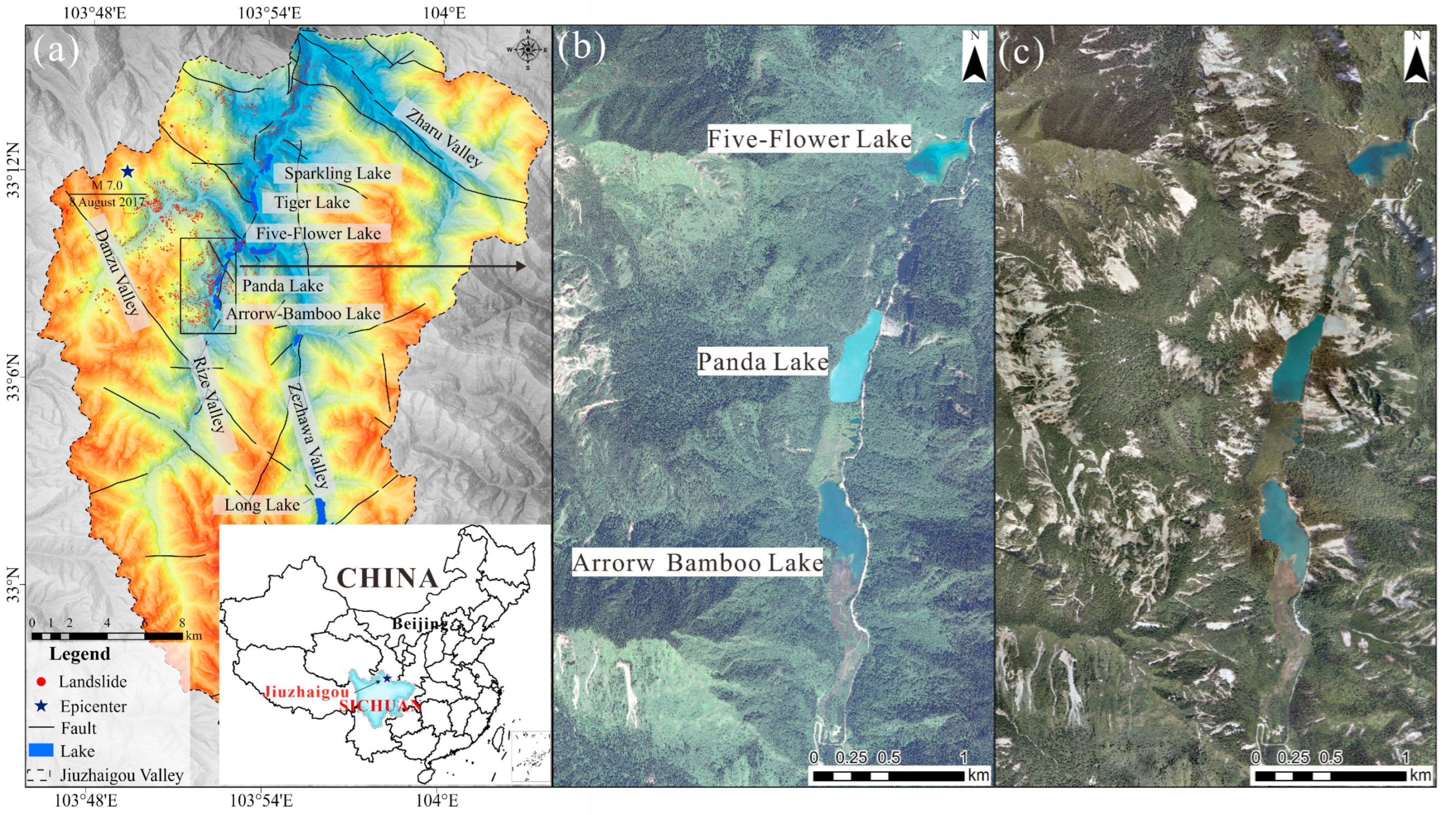
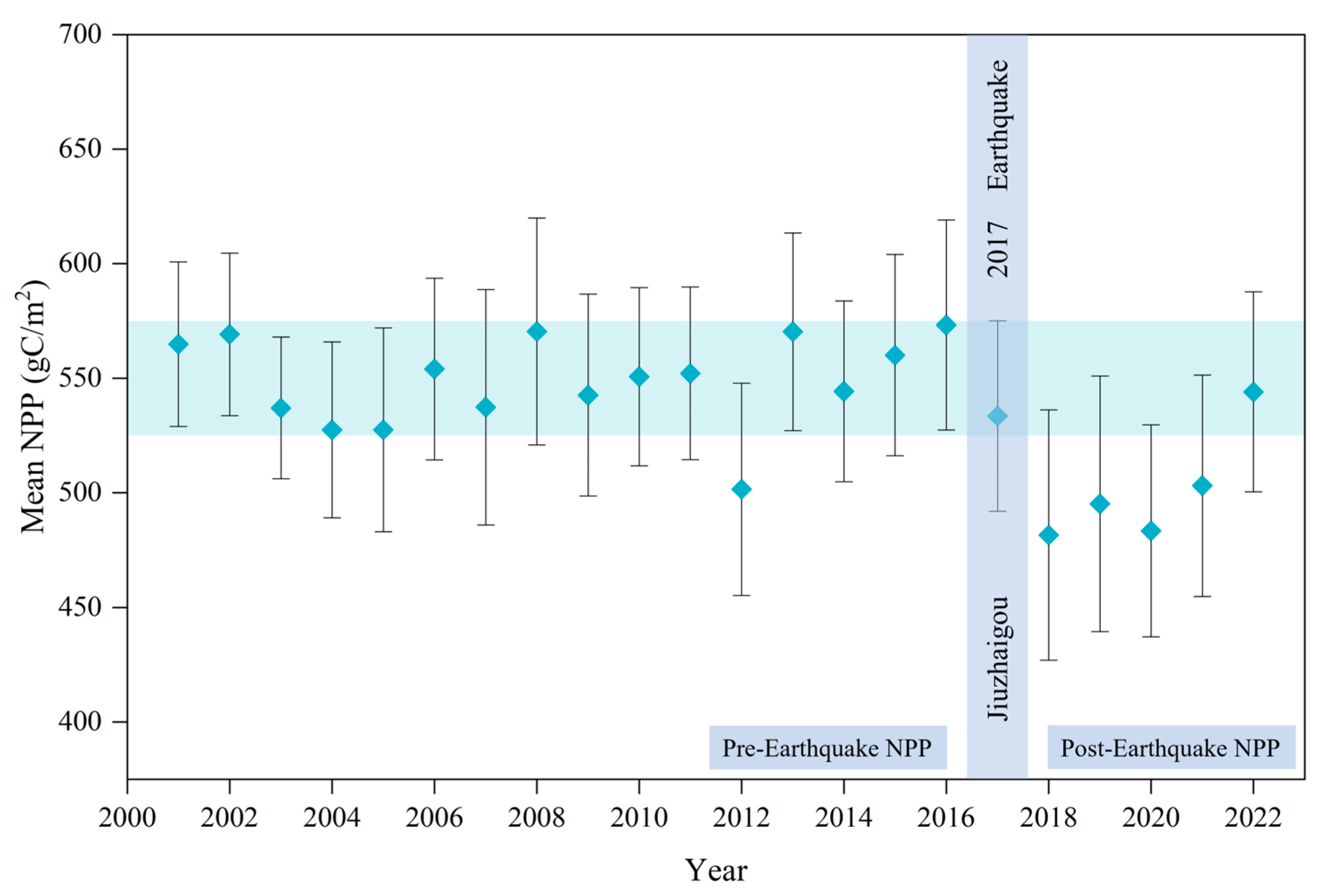
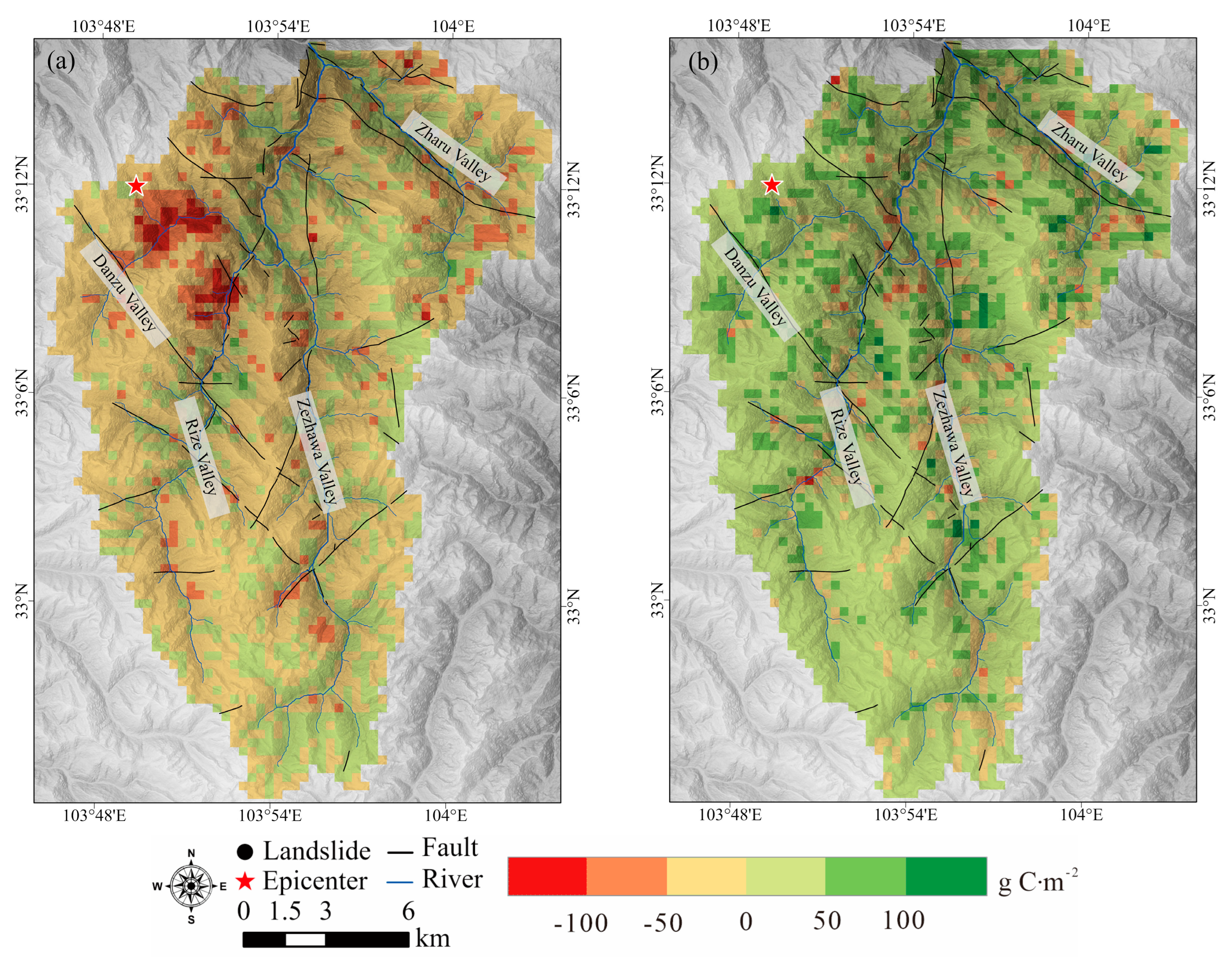
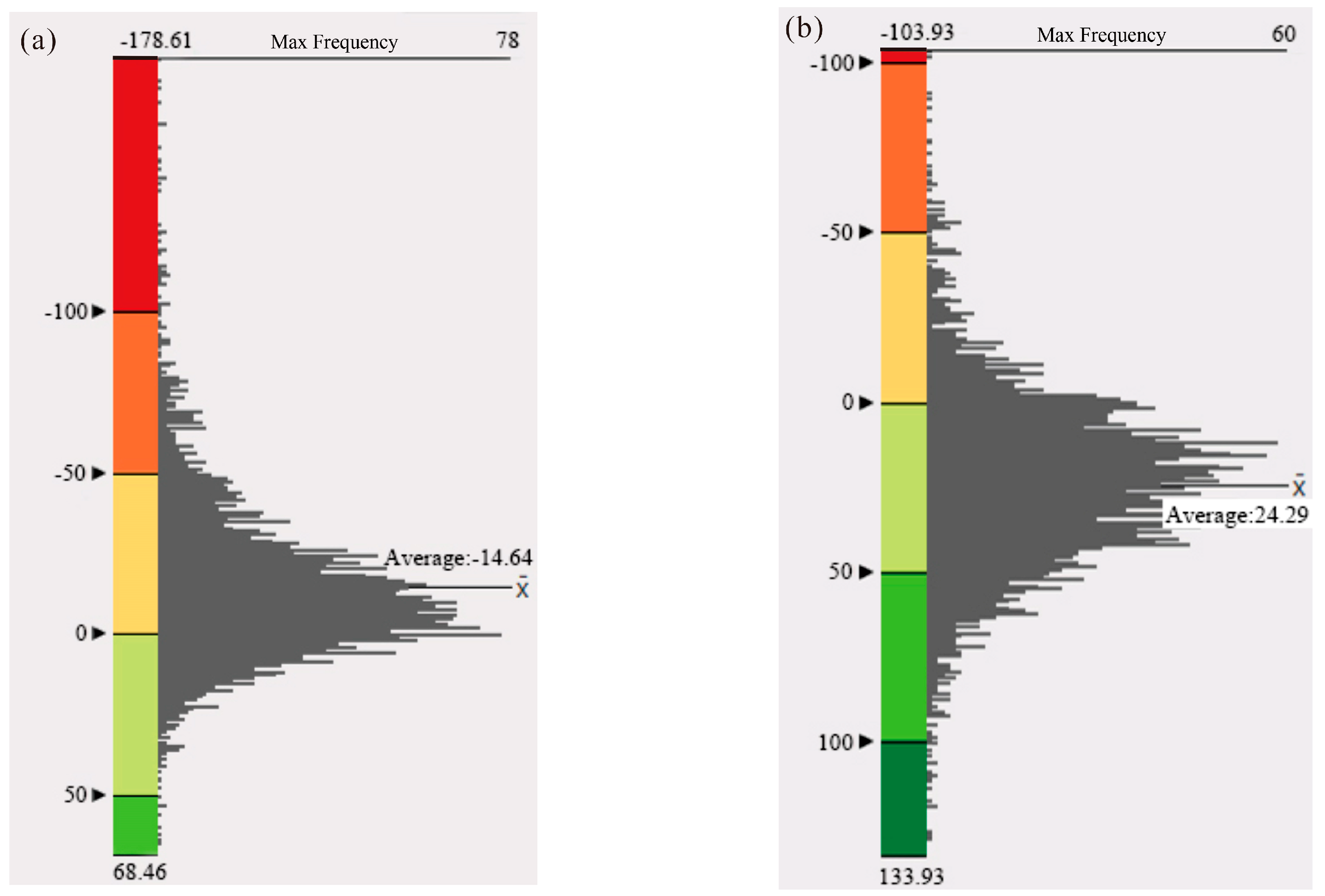
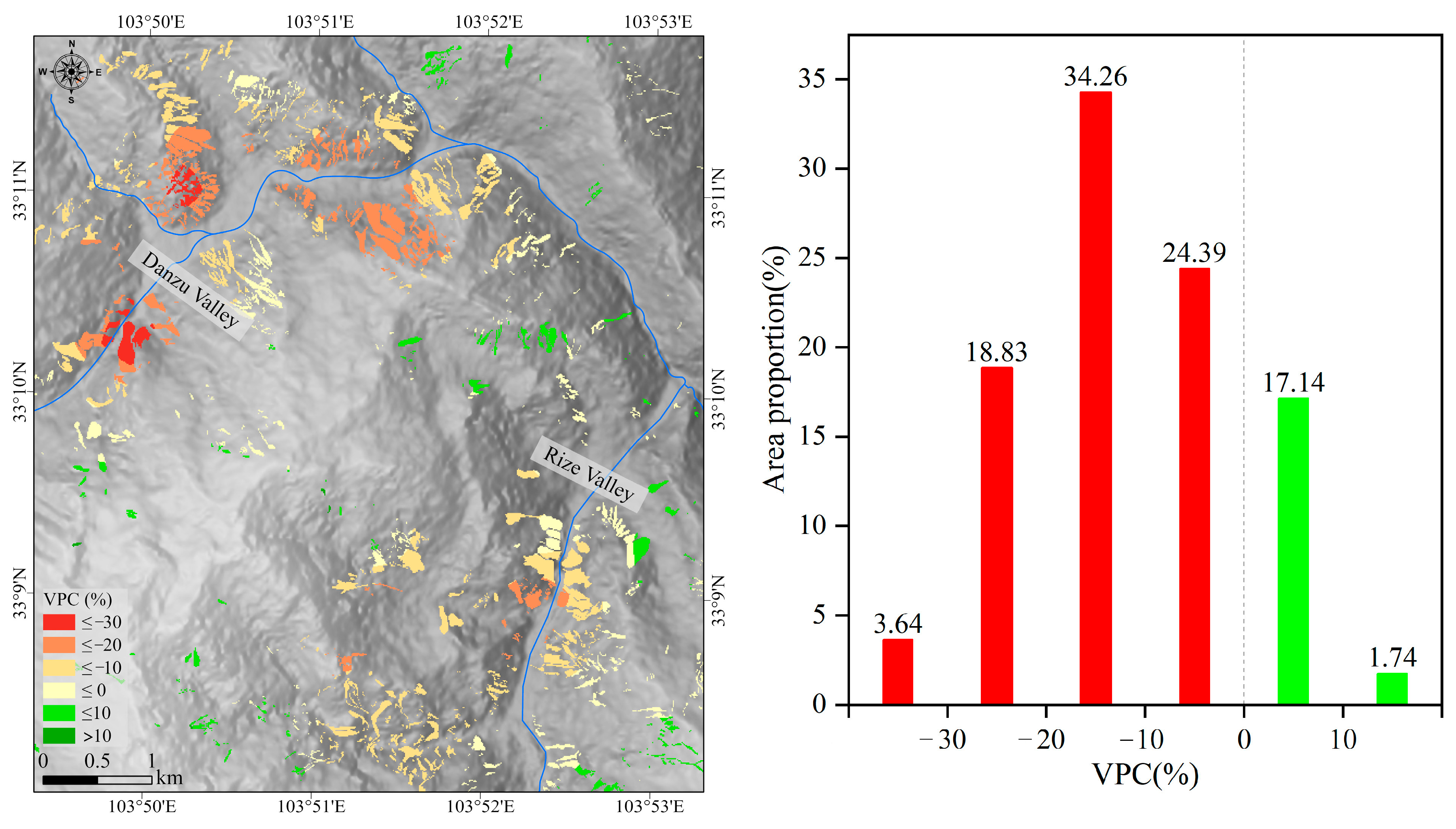
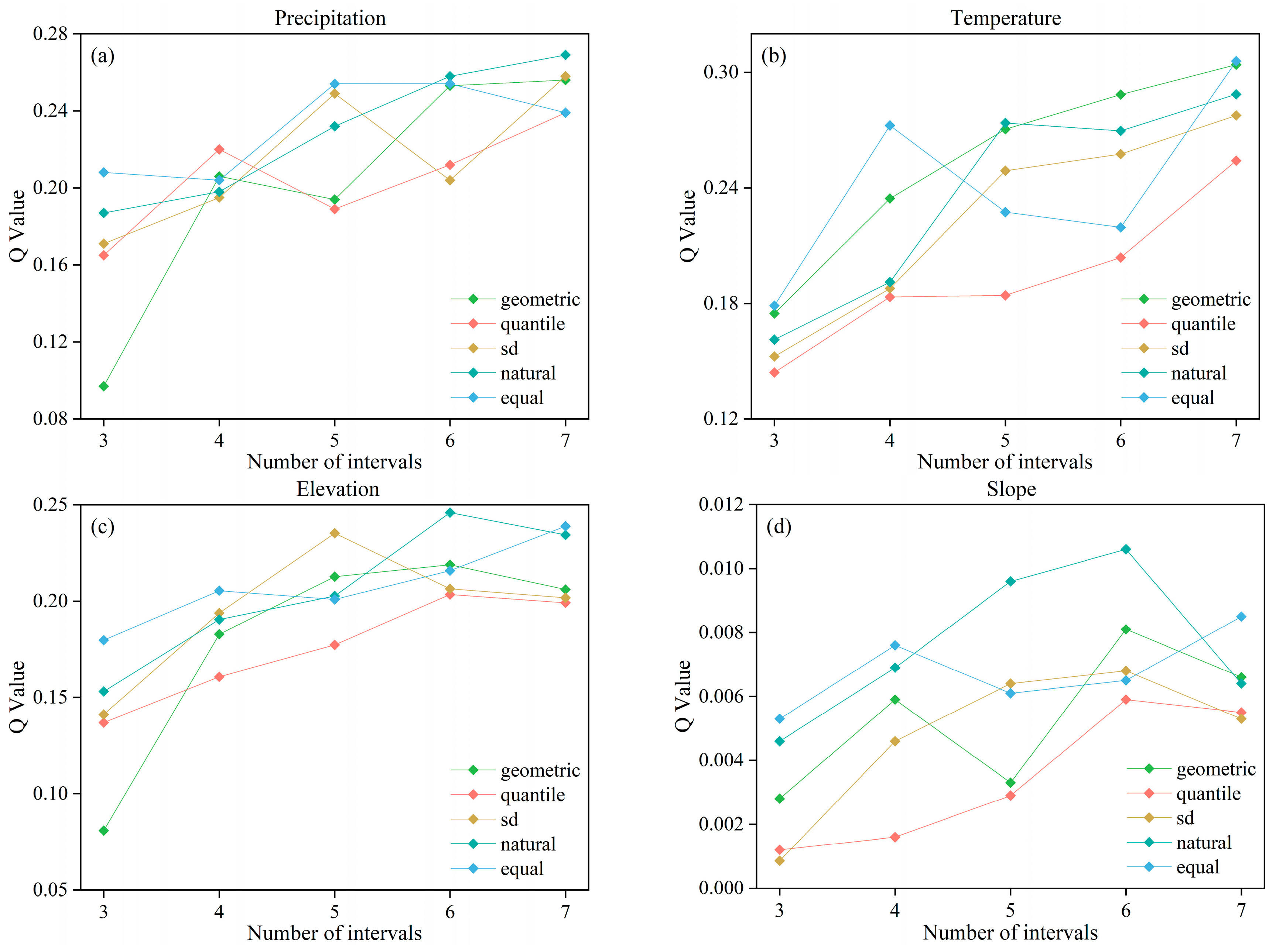
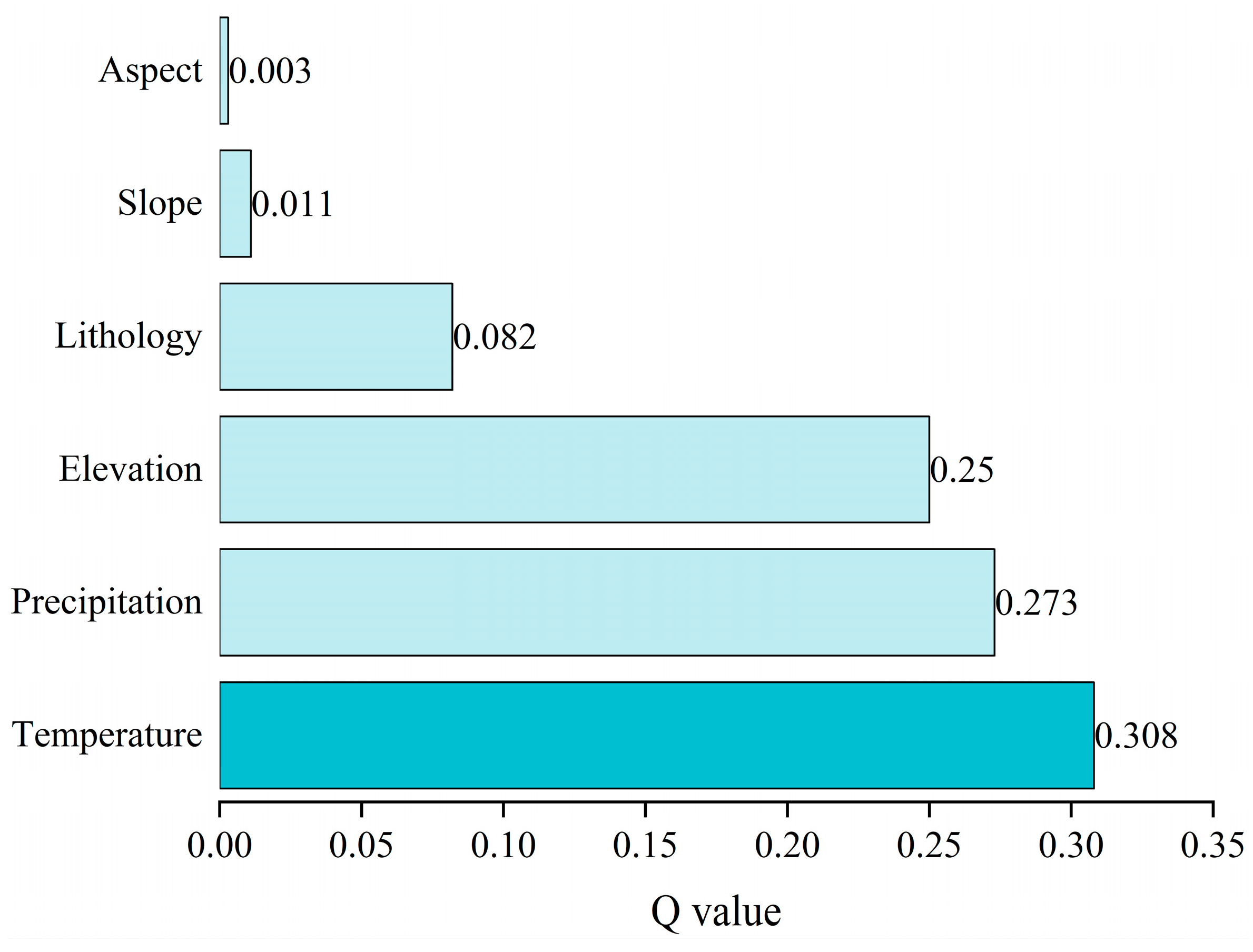

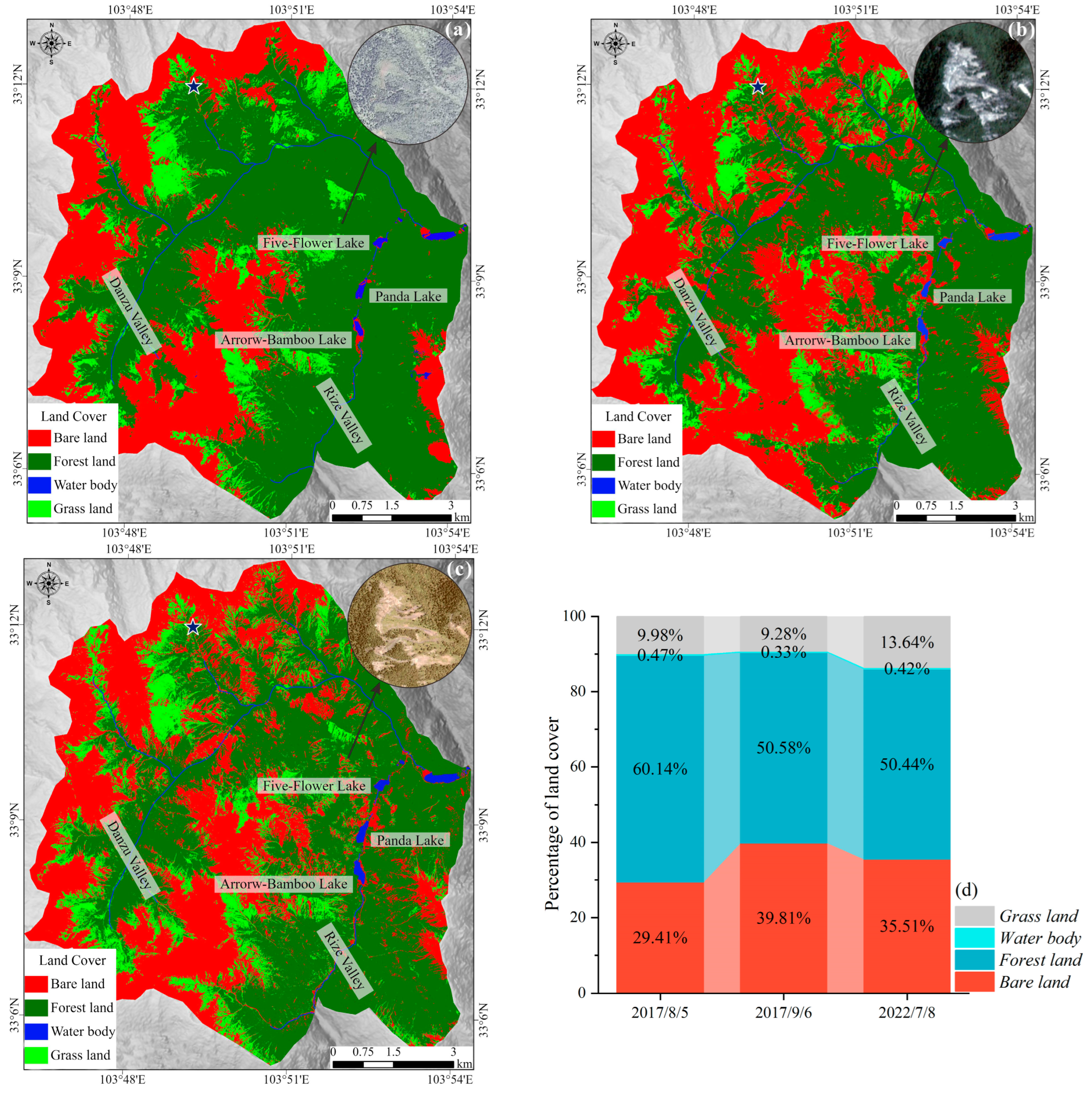
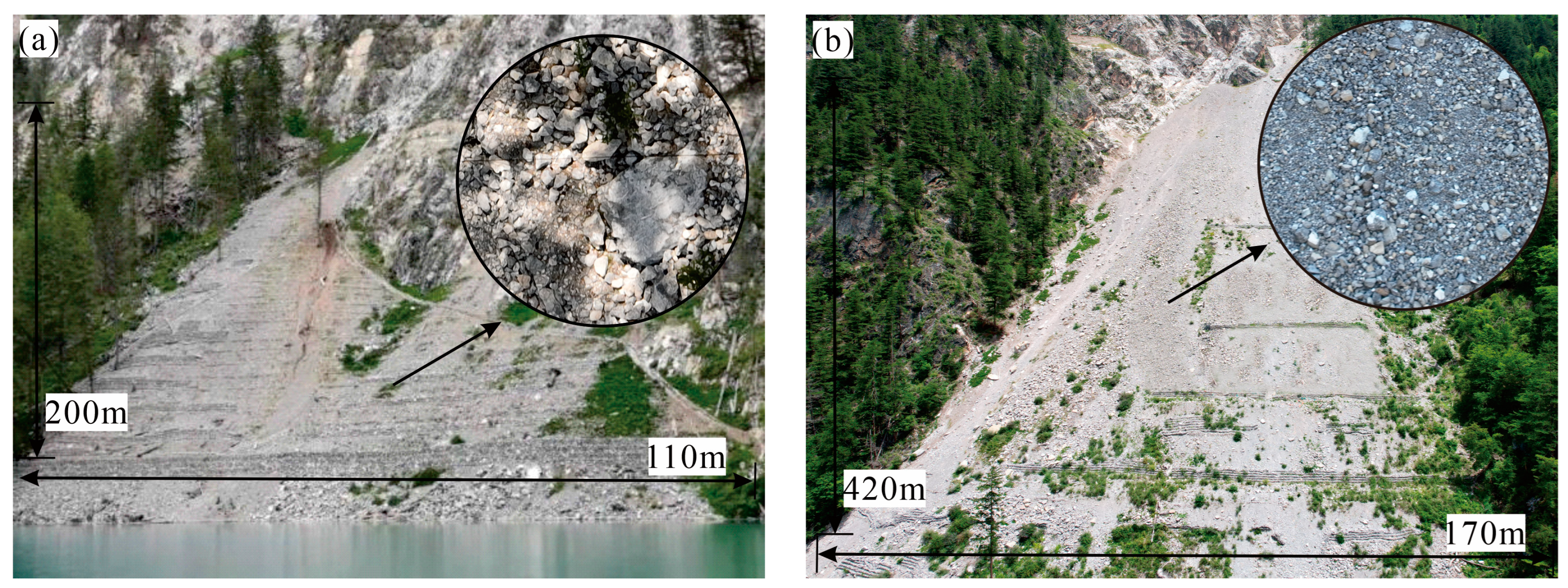
| Interaction Relationship | Interaction |
|---|---|
| Qa∩b < min (Qa, Qb) | Nonlinear weaken: Impacts of single variables are nonlinearly weakened by the interaction of two variables. |
| min (Qa, Qb) ≤ Qa∩b ≤ max (Qa, Qb) | Uni-variable weaken: Impacts of single variables are univariably weakened by the interaction. |
| max (Qa, Qb) < Qa∩b < (Qa + Qb) | Bi-variable enhance: Impact of single variables are bi-variably enhanced by the interaction. |
| Qa∩b = (Qa + Qb) | Independent: Impacts of variables are independent. |
| Qa∩b > (Qa + Qb) | Nonlinear enhance: Impacts of variables are nonlinearly enhanced. |
| Forest Land | Grassland | Water Body | Bare Land | |
|---|---|---|---|---|
| Resilience coefficient | 0.5 | 0.8 | 0.7 | 0.1 |
| Resistance coefficient | 1 | 0.7 | 0.8 | 0.2 |
| Ecosystem resilience | 0.7 | 0.76 | 0.74 | 0.14 |
| Variable | Min | Max | Discretization Method | No. of Intervals |
|---|---|---|---|---|
| Precipitation (mm) | 60.61 | 73.85 | Natural | 7 |
| Temperature (°C) | −2.34 | 8.03 | Equal | 7 |
| Elevation (m) | 2069.31 | 4320.80 | Natural | 6 |
| Slope (°) | 3.67 | 72.90 | Natural | 6 |
| Aspect | Categorical variables, including Flat, North, Northeast, East, Southeast, South, Southwest, West, and Northwest | 9 | ||
| Lithology | Categorical variable, including Pds1, Pds2, Cpd1, Cpd2, Cm1, Cm2, Q, T2zg, Dcy, T1h, T2q, and T1l | 12 | ||
| 5 August 2017 | 6 September 2017 | 8 July 2022 | |
|---|---|---|---|
| Sensor | Planet | Planet | GF-2 |
| Resolution | 3 m | 3 m | 1 m |
| 5 August 2017 | 6 September 2017 | 8 July 2022 | |
|---|---|---|---|
| Ecosystem resilience | 0.54 | 0.48 | 0.51 |
Disclaimer/Publisher’s Note: The statements, opinions and data contained in all publications are solely those of the individual author(s) and contributor(s) and not of MDPI and/or the editor(s). MDPI and/or the editor(s) disclaim responsibility for any injury to people or property resulting from any ideas, methods, instructions or products referred to in the content. |
© 2024 by the authors. Licensee MDPI, Basel, Switzerland. This article is an open access article distributed under the terms and conditions of the Creative Commons Attribution (CC BY) license (https://creativecommons.org/licenses/by/4.0/).
Share and Cite
Duan, Y.; Pei, X.; Luo, J.; Zhang, X.; Luo, L. Disentangling the Spatiotemporal Dynamics, Drivers, and Recovery of NPP in Co-Seismic Landslides: A Case Study of the 2017 Jiuzhaigou Earthquake, China. Forests 2024, 15, 1381. https://doi.org/10.3390/f15081381
Duan Y, Pei X, Luo J, Zhang X, Luo L. Disentangling the Spatiotemporal Dynamics, Drivers, and Recovery of NPP in Co-Seismic Landslides: A Case Study of the 2017 Jiuzhaigou Earthquake, China. Forests. 2024; 15(8):1381. https://doi.org/10.3390/f15081381
Chicago/Turabian StyleDuan, Yuying, Xiangjun Pei, Jing Luo, Xiaochao Zhang, and Luguang Luo. 2024. "Disentangling the Spatiotemporal Dynamics, Drivers, and Recovery of NPP in Co-Seismic Landslides: A Case Study of the 2017 Jiuzhaigou Earthquake, China" Forests 15, no. 8: 1381. https://doi.org/10.3390/f15081381
APA StyleDuan, Y., Pei, X., Luo, J., Zhang, X., & Luo, L. (2024). Disentangling the Spatiotemporal Dynamics, Drivers, and Recovery of NPP in Co-Seismic Landslides: A Case Study of the 2017 Jiuzhaigou Earthquake, China. Forests, 15(8), 1381. https://doi.org/10.3390/f15081381





